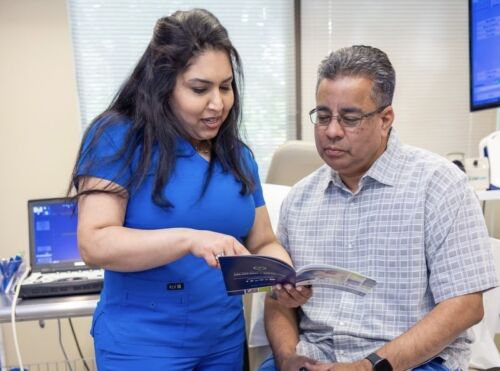Are you having trouble falling asleep? It might have something to do with your blood flow. Learn how you can improve circulation in your legs to get better sleep.
Are leg cramps and pain keeping you up at night? It could be due to poor circulation in your leg veins, a condition known as chronic venous insufficiency (CVI).
CVI symptoms can be particularly bothersome in the evenings. If you’re tossing and turning at bedtime, you’re not the only one going through it! One study estimated between 25 to 40 percent of women have chronic venous insufficiency compared to 10 to 20 percent of men. But you don’t have to suffer sleeplessness! Learn how you can improve circulation in the legs while sleeping.
Why poor circulation keeps you up at night
Your arteries deliver oxygenated blood to your tissues and organs. Your veins then return deoxygenated blood to the heart for another dose of oxygen. However, venous insufficiency prevents the veins from effectively carrying blood back to the heart. Due to various factors, including a sedentary lifestyle, obesity, heredity, and even gender, tiny valves that line the veins walls can weaken, allowing blood to backflow and pool in the vein.
As blood pressure builds in the vein, your legs and ankles swell, become painful, and feel heavy. Your legs may throb and feel itchy, too. Varicose veins, the most common sign of venous insufficiency, may also bulge from under the skin on the legs and feet.
Chronic venous insufficiency symptoms tend to worsen in the evening. One study established a relationship between CVI and restless leg syndrome (RLS), with patients seeing improved RLS symptoms after undergoing treatment for CVI.
How to improve your circulation while sleeping
Did you know that you can boost your circulation when you’re resting? Before you go to bed and while you sleep, try these simple tips to sleep through the night and wake refreshed:
Take a warm bath. Soaking in a warm tub loosens tense muscles and can help you fall asleep. While in the tub, massage your legs to promote circulation.
Do gentle exercises. Ease your way into sleep by doing gentle exercises in bed. As you lie on your back with your feet straight ahead, flex your foot with the toes pointed at the ceiling. Do one foot at a time or both together. A mild stretch before bedtime can also feel relaxing. These simple exercises will move blood through the veins while not being so vigorous you’ll lie awake for hours.
Prop up your legs. Blood pools in the leg veins because of gravity. But you can counter that force by propping your legs on a wedge pillow or a pile of blankets. Elevating your legs above your heart as you sleep can drain blood back to the heart and prevent blood from pooling.
What you do during the day matters, too. If you’re traveling over several hours or work at a job that requires you to sit or stand all day, wear compression stockings that gently squeeze the veins and keep blood moving. By the end of the day, you should notice less swelling in your legs.
For a long-term solution, explore one of several minimally invasive vein treatments that address the root problem: CVI. These quick, painless procedures remove the damaged vein, diverting blood to healthy ones.
Painful legs? Get your circulation checked today
Chronic venous insufficiency symptoms can interrupt your daily life, including the quality of sleep. But you can easily find relief at a Center for Vein Restoration (CVI) full-service vein care office near you. Our board-certified physicians have years of experience successfully treating CVI and varicose veins using the latest techniques. We’ll tailor a treatment plan that combines surgical and conservative methods.
Contact your nearest CVR location today to schedule a consultation or speak to a representative. You may also schedule online at your convenience.

 About Vein Disease
About Vein Disease
 Spider Veins
Spider Veins
 Varicose Veins
Varicose Veins
 Vein Disease Treatments
Vein Disease Treatments
 Treating Spider Veins
Treating Spider Veins
 Treating Varicose Veins
Treating Varicose Veins
 About Us
About Us
 Patient Resources
Patient Resources
 Physician Resources
Physician Resources


